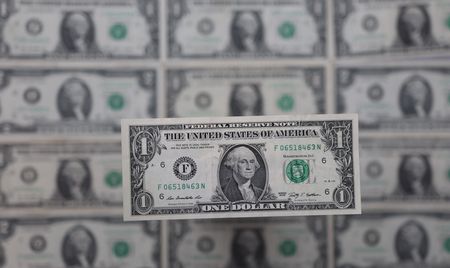
By Alun John
HONG KONG (Reuters) – The dollar index held firm on Tuesday, supported by high U.S. yields ahead of inflation data that is expected to show U.S. prices gained the most in over 16 years, reinforcing expectations of aggressive Fed tightening policy.
The index rose as high as 100.13, testing last week’s near two-year high of 100.19, before hovering just below 100.
The dollar’s recent gains against the yen (JPY) have been its most striking. The U.S. currency was trading choppily at 125.22 yen on Tuesday, in sight of the overnight intraday high of 125.77, which was near its June 2015 peak of 125.86. A move past that level would take the dollar to its highest against the yen since 2002.
Japanese Finance Minister Shunichi Suzuki on Tuesday declined to comment on specific prices in foreign exchange markets but said that the government was closely watching the yen and that excess volatility and disorderly movements could have an adverse effect on the economy and financial stability.
The dollar also gained steadily overnight on the offshore Chinese yuan (CNH), reaching a two-week high of 6.390 in early trade before softening.
The dollar’s strength “was most apparent against JPY and CNH – currencies of economies with a dovish central bank,” said analysts at CBA in a morning note.
The Bank of Japan has repeatedly intervened to keep benchmark bond yields around zero.
CBA analysts said they expected that very high U.S. inflation would reinforce expectations of aggressive Federal Reserve tightening. Because the market had not yet fully priced in a 50-basis-point rate hike at each of the next two Fed meetings, they expected further gains for the dollar.
“We expect the dollar to stay bid and lift to the pandemic high of 103 pts in coming months,” they said.
U.S. consumer prices likely increased by the most in 16-1/2 years in March, according to a Reuters poll of economists, as the war in Ukraine boosted the cost of gasoline to record highs.
Meanwhile U.S. longer-term yields inched higher, though gains were more muted than in recent days.
The yield on benchmark 10-year notes rose to 2.836%, its highest since December 2018, before steadying. If Tuesday’s early advance holds, it will be the eighth straight session of gains for benchmark yields.
The yield on the 30-year Treasury bond touched 2.86% in early trade, its highest since May 2019,
Elsewhere, the euro was unable to hold on to gains from its minor relief rally on Monday after French leader Emmanuel Macron beat far-right challenger Marine Le Pen in the first round of presidential voting.
The euro was last at $1.0877, little changed from its Friday close.
“The bottom line, then, is that we are where we were before yesterday’s vote,” said Rabobank analysts.
“Macron looks set to return to office following the April 24 vote but the scale of his victory is likely to be far smaller than when he was seen as an upstart five years ago and likely slim enough that the political earthquake that would be a Le Pen victory cannot be entirely discounted.”
The Australian dollar steadied at $0.7425 after four straight sessions of losses, as lower oil prices weighed on the commodity-linked currency.
The New Zealand dollar was steady at $0.6828, ahead of a closely watched meeting by the Reserve Bank of New Zealand at which a 50-basis-point rate hike is on the cards. [RBNZWATCH]
Sterling was soft at $1.30245.
(Reporting by Alun John; Editing by Kenneth Maxwell and Bradley Perrett)

